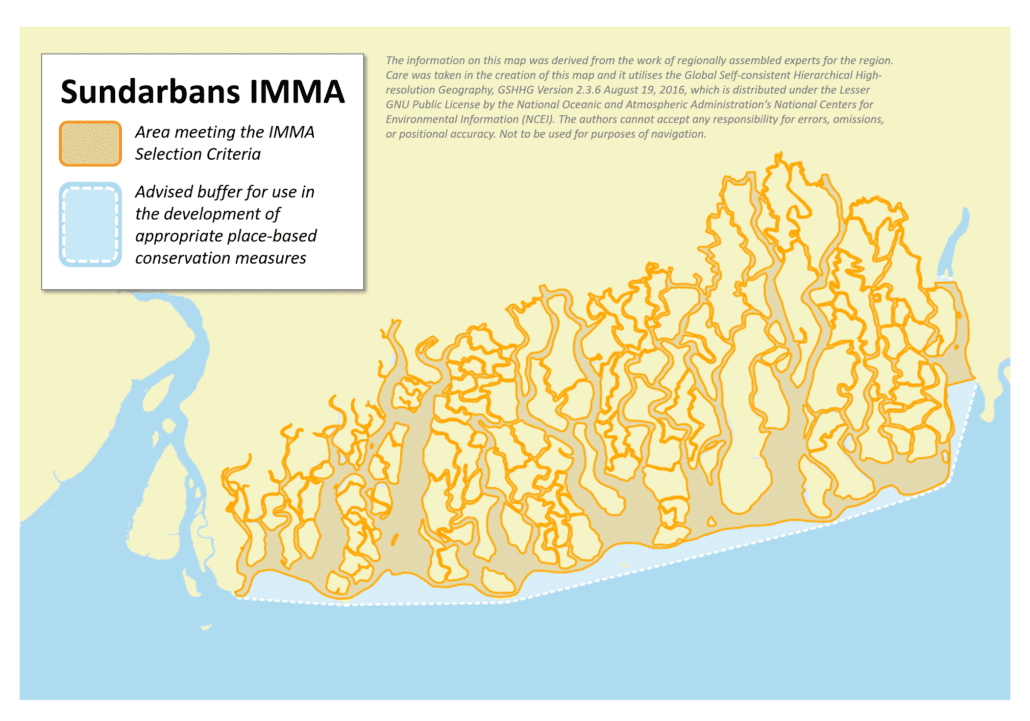Size in Square Kilometres
3,663
Qualifying Species and Criteria
Ganges River dolphin – Platanista gangetica
Criterion A; B (2)
Irrawaddy dolphin – Orcaella brevirostris
Criterion A; B (2)
Criterion D (2) – Marine Mammal Diversity
Other Marine Mammal Species Documented
Neophocaena phocaenoides, Sousa chinensis
Summary
The Sundarbans is the world’s largest mangrove forest. Tidal waterways in the Bangladesh portion, which covers about 2/3s of the total forest, support globally significant populations of Endangered Ganges River dolphins (Platanista gangetica – roughly 225 individuals) and Irrawaddy dolphins (Orcaella brevirostris– roughly 451 individuals). Although no population estimates exist, and salinity levels are higher in the Indian side of the Sundarbans, ecological similarities and scattered reports of Irrawaddy dolphin occurrence imply that these waterways are also important for this species.
Description of Qualifying Criteria
Criterion A – Species or Population Vulnerability
The occurrence of globally significant populations of two Endangered dolphin species including the Ganges river dolphin (Platanista gangetica) assessed as IUCN Red List category Endangered [A2abcde+3bcde+4abcde] (Kelkar et al. 2022) and the Irrawaddy dolphin (Orcaella brevirostris) recently assessed as IUCN Red List category Endangered [A2cd+3cd+4cd] (Minton et al. 2017).
Criterion B – Distribution and Abundance
Sub-criterion B1 – Small and Resident Populations
Sub-criterion B2 – Aggregations
Large population sizes have been assessed for both Ganges river dolphins (n=225) and Irrawaddy dolphins (n=451), with relatively high encounter rates observed within the IMMA compared to other areas where both species occur (Smith et al. 2006). Similar mangrove channel habitat occurs across the border with India.
Criterion C: Key Life Cycle Activities
Sub-criterion C1 – Reproductive Areas
Sub-criterion C2: Feeding Areas
Sub-criterion C3: Migration Routes
C3a – Whale Seasonal Migratory Route
C3b – Migration / Movement Area
Criterion D – Special Attributes
Sub-criterion D1 – Distinctiveness
Sub-criterion D2 – Diversity
Supporting Information
Danda, A.A., Joshi, A.K., Ghosh, A. and Saha, R. eds. 2017. State of Art Report on Biodiversity in IndianSundarbans. World Wide Fund for Nature-India, New Delhi. 342 pp.
Hussain, Z. and Karim, A. 1994. Introduction. In Mangroves of the Sundarbans, Volume Two: Bangladesh, Hussain Z, Acharya G. (eds). IUCN: Bangkok, Thailand; 1–10.
Kelkar, N., Smith, B.D., Alom, M.Z., Dey, S., Paudel, S. and Braulik, G.T. 2022. Platanista gangetica. The IUCN Red List of Threatened Species 2022: e.T41756A50383346. https://dx.doi.org/10.2305/IUCN.UK.2022-1.RLTS.T41756A50383346.en. Accessed on 05 September 2022.
Mansur, E.F., Smith, B.D., Mowgli, R.M. and Diyan, M.A.A., 2008. Two incidents of fishing gear entanglement of Ganges River dolphins (Platanista gangetica gangetica) in waterways of the Sundarbans mangrove forest, Bangladesh. Aquatic mammals, 34(3):362.
Minton, G., Smith, B.D., Braulik, G.T., Kreb, D., Sutaria, D. and Reeves, R. 2017. Orcaella brevirostris (errata version published in 2018). The IUCN Red List of Threatened Species 2017: e.T15419A123790805. http://dx.doi.org/10.2305/IUCN.UK.2017-3.RLTS.T15419A50367860.en
Marine Mammal Conservation Network of India. 2018. Marine Mammal Conservation Network of India Sightings and Stranding Database accessed 28 October 2018,
Mirza, M.Q. 1998. Diversion of the Ganges water at Farakka and its effects on salinity in Bangladesh. Environmental Management 22:711–722.
Smith, B.D., Braulik, G., Strindberg, S., Ahmed, B. and Mansur, R., 2006. Abundance of Irrawaddy dolphins (Orcaella brevirostris) and Ganges river dolphins (Platanista gangetica gangetica) estimated using concurrent counts made by independent teams in waterways of the Sundarbans mangrove forest in Bangladesh. Marine Mammal Science, 22(3):527-547.
Smith, B.D. and Braulik, G.T., 2009. Susu and Bhulan: Platanista gangetica gangetica and P. g. minor. In Encyclopedia of Marine Mammals (Second Edition) (pp. 1135-1139).
Smith, B.D., Braulik, G., Strindberg, S., Mansur, R., Diyan, M.A.A. and Ahmed, B., 2009. Habitat selection of freshwater‐dependent cetaceans and the potential effects of declining freshwater flows and sea‐level rise in waterways of the Sundarbans mangrove forest, Bangladesh. Aquatic Conservation: Marine and Freshwater Ecosystems, 19(2):209-225.
Smith, B.D., Diyan, M.A.A., Mansur, R.M., Mansur, E.F. and Ahmed, B., 2010. Identification and channel characteristics of cetacean hotspots in waterways of the eastern Sundarbans mangrove forest, Bangladesh. Oryx, 44(2):241-247.
Downloads
Download the full account of the Sundarbans IMMA using the Brochure button below:
To make a request to download the GIS Layer (shapefile and/or geojson) for the Sundarbans IMMA please complete the following Contact Form:



